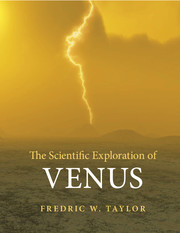Book contents
- Frontmatter
- Contents
- Overview
- Prologue
- A note on scientific units
- Acknowledgements
- Part I Views of Venus, from the beginning to the present day
- Chapter 1 The dawn of Venus exploration
- Chapter 2 Mariner and Venera
- Chapter 3 Pioneer Venus and Vega
- Chapter 4 Images of the surface
- Chapter 5 The forgotten world
- Chapter 6 Earth-based astronomy delivers a breakthrough
- Chapter 7 Can’t stop now
- Chapter 8 Europe and Japan Join In
- Part II The motivation to continue the quest
- Part III Plans and visions for the future
- Epilogue
- References and acknowledgements
- Appendix A Chronology of space missions to Venus
- Appendix B Data about Venus
- Index
- Plate section
- References
Chapter 1 - The dawn of Venus exploration
from Part I - Views of Venus, from the beginning to the present day
Published online by Cambridge University Press: 05 September 2014
- Frontmatter
- Contents
- Overview
- Prologue
- A note on scientific units
- Acknowledgements
- Part I Views of Venus, from the beginning to the present day
- Chapter 1 The dawn of Venus exploration
- Chapter 2 Mariner and Venera
- Chapter 3 Pioneer Venus and Vega
- Chapter 4 Images of the surface
- Chapter 5 The forgotten world
- Chapter 6 Earth-based astronomy delivers a breakthrough
- Chapter 7 Can’t stop now
- Chapter 8 Europe and Japan Join In
- Part II The motivation to continue the quest
- Part III Plans and visions for the future
- Epilogue
- References and acknowledgements
- Appendix A Chronology of space missions to Venus
- Appendix B Data about Venus
- Index
- Plate section
- References
Summary
The Evening Star and the Morning Star
Everyone has seen Venus, as a bright, starlike apparition in the evening sky, following the Sun down towards the horizon and setting a few hours later. At various other times of the year, there comes a brief season where an early bird can see Venus rise brilliantly before the Sun, climbing higher until it seems to dim and vanish as the sky brightens after sunrise. When it rises before the Sun, people have long called Venus the Morning Star; half an orbit later, when on the other side of the Sun so that the Sun sets first, Venus is the Evening Star. Before Copernicus promoted the idea that planets orbit the Sun, it was not obvious that these two phenomena were the same body, and early civilisations had distinct names for them. To the Greeks, they were Phosphoros and Hesperos.
For much of the year, Venus sets and rises so near the Sun that we tend not to notice it. During the day, like the true stars at vastly greater distances, Venus is still overhead and just as bright, of course, but it is hard to see because the contrast with the dark sky is lost when the Sun is up. It can be studied during the day if a telescope is used to shut out most of the sunlight, and even with ordinary binoculars if you know where to look. In any observations made over a period of a few months, Venus can be seen to exhibit lunarlike phases (Figure 1.1).
- Type
- Chapter
- Information
- The Scientific Exploration of Venus , pp. 3 - 16Publisher: Cambridge University PressPrint publication year: 2014



